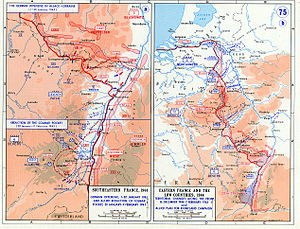Operation Nordwind
| Operation North Wind | |||||||
|---|---|---|---|---|---|---|---|
| Part of the Western Front of World War II | |||||||
 Operation Nordwind |
|||||||
|
|||||||
| Belligerents | |||||||
|
|
|
||||||
| Commanders and leaders | |||||||
|
|
|
||||||
| Units involved | |||||||
|
|||||||
| Strength | |||||||
|
|
? | ||||||
| Casualties and losses | |||||||
|
|
|
||||||
Operation North Wind (Unternehmen Nordwind) was the last major German offensive of World War II on the Western Front. It began on 31 December 1944 in Alsace and Lorraine in northeastern France, and ended on 25 January.
In a briefing at his military command complex at Adlerhorst, Adolf Hitler declared in his speech to his division commanders on 28 December 1944 (three days prior to the launch of Operation Nordwind): "This attack has a very clear objective, namely the destruction of the enemy forces. There is not a matter of prestige involved here. It is a matter of destroying and exterminating the enemy forces wherever we find them."
The goal of the offensive was to break through the lines of the U.S. Seventh Army and French 1st Army in the Upper Vosges mountains and the Alsatian Plain, and destroy them. This would leave the way open for Operation Dentist (Unternehmen Zahnarzt), a planned major thrust into the rear of the U.S. Third Army which would lead to the destruction of that army.
On 31 December 1944, German Army Group G—commanded by Generaloberst Johannes Blaskowitz—and Army Group Oberrhein ("Upper Rhein")—commanded by Reichsführer-SS Heinrich Himmler—launched a major offensive against the thinly stretched, 110 kilometres (68 mi)-long front line held by the U.S. 7th Army. Operation Nordwind soon had the understrength U.S. 7th Army in dire straits. The 7th Army —at the orders of U.S. General Dwight D. Eisenhower— had sent troops, equipment, and supplies north to reinforce the American armies in the Ardennes involved in the Battle of the Bulge.
...
Wikipedia
